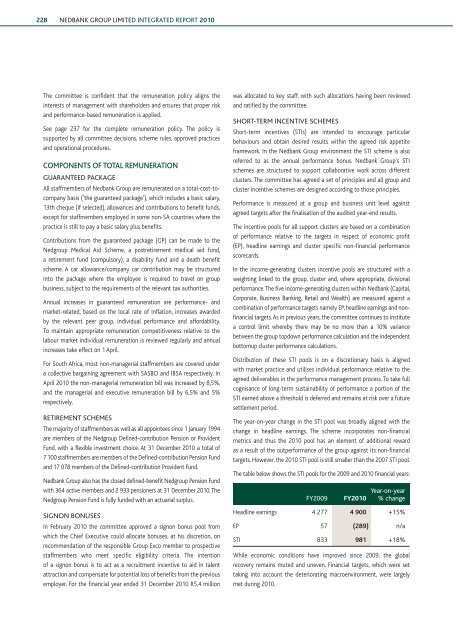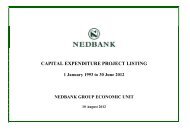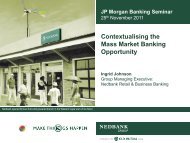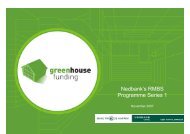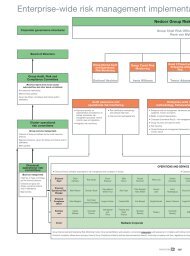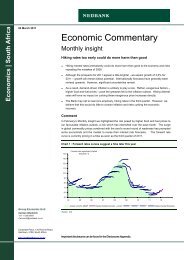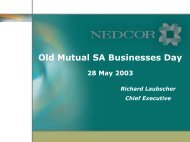Download the PDF (5.4 MB) - Nedbank Group Limited
Download the PDF (5.4 MB) - Nedbank Group Limited
Download the PDF (5.4 MB) - Nedbank Group Limited
You also want an ePaper? Increase the reach of your titles
YUMPU automatically turns print PDFs into web optimized ePapers that Google loves.
228 NEDBANK GROUP <strong>Limited</strong> INTEGRATED REPORT 2010The committee is confident that <strong>the</strong> remuneration policy aligns <strong>the</strong>interests of management with shareholders and ensures that proper riskand performance-based remuneration is applied.See page 237 for <strong>the</strong> complete remuneration policy. The policy issupported by all committee decisions, scheme rules, approved practicesand operational procedures.Components of total remunerationGuaranteed packageAll staffmembers of <strong>Nedbank</strong> <strong>Group</strong> are remunerated on a total-cost-tocompanybasis (‘<strong>the</strong> guaranteed package’), which includes a basic salary,13th cheque (if selected), allowances and contributions to benefit funds,except for staffmembers employed in some non-SA countries where <strong>the</strong>practice is still to pay a basic salary plus benefits.Contributions from <strong>the</strong> guaranteed package (GP) can be made to <strong>the</strong>Nedgroup Medical Aid Scheme, a postretirement medical aid fund,a retirement fund (compulsory), a disability fund and a death benefitscheme. A car allowance/company car contribution may be structuredinto <strong>the</strong> package where <strong>the</strong> employee is required to travel on groupbusiness, subject to <strong>the</strong> requirements of <strong>the</strong> relevant tax authorities.Annual increases in guaranteed remuneration are performance- andmarket-related, based on <strong>the</strong> local rate of inflation, increases awardedby <strong>the</strong> relevant peer group, individual performance and affordability.To maintain appropriate remuneration competitiveness relative to <strong>the</strong>labour market individual remuneration is reviewed regularly and annualincreases take effect on 1 April.For South Africa, most non-managerial staffmembers are covered undera collective bargaining agreement with SASBO and IBSA respectively. InApril 2010 <strong>the</strong> non-managerial remuneration bill was increased by 8,5%,and <strong>the</strong> managerial and executive remuneration bill by 6,5% and 5%respectively.Retirement schemesThe majority of staffmembers as well as all appointees since 1 January 1994are members of <strong>the</strong> Nedgroup Defined-contribution Pension or ProvidentFund, with a flexible investment choice. At 31 December 2010 a total of7 100 staffmembers are members of <strong>the</strong> Defined-contribution Pension Fundand 17 078 members of <strong>the</strong> Defined-contribution Provident Fund.<strong>Nedbank</strong> <strong>Group</strong> also has <strong>the</strong> closed defined-benefit Nedgroup Pension Fundwith 364 active members and 2 933 pensioners at 31 December 2010. TheNedgroup Pension Fund is fully funded with an actuarial surplus.Signon bonusesIn February 2010 <strong>the</strong> committee approved a signon bonus pool fromwhich <strong>the</strong> Chief Executive could allocate bonuses, at his discretion, onrecommendation of <strong>the</strong> responsible <strong>Group</strong> Exco member to prospectivestaffmembers who meet specific eligibility criteria. The intentionof a signon bonus is to act as a recruitment incentive to aid in talentattraction and compensate for potential loss of benefits from <strong>the</strong> previousemployer. For <strong>the</strong> financial year ended 31 December 2010 R5,4 millionwas allocated to key staff, with such allocations having been reviewedand ratified by <strong>the</strong> committee.Short-term incentive schemesShort-term incentives (STIs) are intended to encourage particularbehaviours and obtain desired results within <strong>the</strong> agreed risk appetiteframework. In <strong>the</strong> <strong>Nedbank</strong> <strong>Group</strong> environment <strong>the</strong> STI scheme is alsoreferred to as <strong>the</strong> annual performance bonus. <strong>Nedbank</strong> <strong>Group</strong>’s STIschemes are structured to support collaborative work across differentclusters. The committee has agreed a set of principles and all group andcluster incentive schemes are designed according to those principles.Performance is measured at a group and business unit level againstagreed targets after <strong>the</strong> finalisation of <strong>the</strong> audited year-end results.The incentive pools for all support clusters are based on a combinationof performance relative to <strong>the</strong> targets in respect of economic profit(EP), headline earnings and cluster specific non-financial performancescorecards.In <strong>the</strong> income-generating clusters incentive pools are structured with aweighting linked to <strong>the</strong> group, cluster and, where appropriate, divisionalperformance. The five income-generating clusters within <strong>Nedbank</strong> (Capital,Corporate, Business Banking, Retail and Wealth) are measured against acombination of performance targets namely EP, headline earnings and nonfinancialtargets. As in previous years, <strong>the</strong> committee continues to institutea control limit whereby <strong>the</strong>re may be no more than a 10% variancebetween <strong>the</strong> group topdown performance calculation and <strong>the</strong> independentbottomup cluster performance calculations.Distribution of <strong>the</strong>se STI pools is on a discretionary basis is alignedwith market practice and utilises individual performance relative to <strong>the</strong>agreed deliverables in <strong>the</strong> performance management process. To take fullcognisance of long-term sustainability of performance a portion of <strong>the</strong>STI earned above a threshold is deferred and remains at risk over a futuresettlement period.The year-on-year change in <strong>the</strong> STI pool was broadly aligned with <strong>the</strong>change in headline earnings. The scheme incorporates non-financialmetrics and thus <strong>the</strong> 2010 pool has an element of additional rewardas a result of <strong>the</strong> outperformance of <strong>the</strong> group against its non-financialtargets. However, <strong>the</strong> 2010 STI pool is still smaller than <strong>the</strong> 2007 STI pool.The table below shows <strong>the</strong> STI pools for <strong>the</strong> 2009 and 2010 financial years:FY2009FY2010Year-on-year% changeHeadline earnings 4 277 4 900 +15%EP 57 (289) n/aSTI 833 981 +18%While economic conditions have improved since 2009, <strong>the</strong> globalrecovery remains muted and uneven. Financial targets, which were settaking into account <strong>the</strong> deteriorating macroenvironment, were largelymet during 2010.


